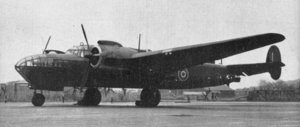Armstrong Whitworth Albemarle
|
|
The Armstrong Whitworth A.W.41 Albemarle was a British twin-engined transport aircraft that entered service during World War II. Originally designed as a medium-bomber, the Albemarle never served in that role, instead being converted for general and special transport duties, paratroop transport and glider towing. Albemarles took part in many of the major British airborne operations such as the invasions of Sicily and Normandy and the assault on Arnhem during Operation Market Garden.
The origin of the Albemarle lay in Air Ministry Specification B.18/38 which required a twin-engined medium bomber of wood and metal construction that could be built by manufacturers outside the aircraft industry. Consequently the entire production run of 600 Albemarles were built by A.W. Hawkesley Ltd of Gloucester. The first of two prototypes built by Armstrong Whitworth flew on March 20, 1940. The original bomber design required for a crew of six including two gunners; one in a 4 gun dorsal turret and one in a twin-gun ventral turret. However only the first 32 aircraft, designated the Mk I Series I, were produced in this configuration and they never operated in a bomber role. All subsequent aircraft were built as transports; designated either "General Transport" (GT) or "Special Transport" (ST).
The most notable design feature of the Albemarle was its undercarriage which included a retractable nose-wheel (in addition to a semi-concealed tail-wheel). It was the first aircraft with this feature to enter service with the Royal Air Force. The first squadron to operate the Albemarle was No. 295 at Harwell in January 1943. Other squadrons to be equipped with the Albemarle were No. 296, No. 297 and No. 570. Other RAF squadrons operated small numbers of the aircraft and some were supplied to the Soviet Air Force.
Albemarle_towing_a_Horsa_glider.jpg
Over the course of its production life, a number of variants of the Albemarle were built:
- ST Mk I - 99 aircraft
- GT Mk I - 69
- ST Mk II - 99
- ST Mk V - 49
- ST Mk VI - 133
- GT Mk VI - 117
Most Marks were divided into "Series" to distinguish differences in equipment. The ST Mk I Series 1 (8 aircraft) had only a twin gun dorsal turret. The 14 ST Mk I Series 2 aircraft were equipped with gear for towing gliders. The Mk II could carry 10 paratroops and the Mk V was essentially the same but with a fuel jettison capability. All production Albemarles were powered by a pair of 1,590 hp Bristol Hercules XI radial engines.
The Mk III and Mk IV Albemarles were development projects testing different powerplants; the former using the Rolls-Royce Merlin III and the latter with the 1,600 hp (1190 kW) Wright Double Cyclone.
| Contents |
Specifications (ST Mk I)
General characteristics
- Crew: 4
- Length: 59 ft 11 in (18.26 m)
- Wingspan: 77 ft (23.47 m)
- Height: 15 ft 7 in (4.75 m)
- Wing area: 804 ft² (74.6 m²)
- Empty: lb ( kg)
- Loaded: 22,600 lb (10,250 kg)
- Maximum takeoff: 36,500 lb (16,556 kg)
- Powerplant: 2 x Bristol Hercules XI radial engines, 1,590 hp (1190 kW)
Performance
- Maximum speed: 265 mph at 10,500 ft (426 km/h at 3,200 m)
- Range: 1,300 miles (2,092 km)
- Service ceiling: 18,000 ft (5,486 m)
- Rate of climb: ft/min ( m/min)
- Wing loading: lb/ft² ( kg/m²)
- Power/mass: hp/lb ( kW/kg)
Armament
- 4 x .303 in (7.7 mm) machine guns in dorsal turret
Related content
Related development: None
Comparable aircraft:
Designation series: A.W.27 - A.W.38 - A.W.41 - A.W.52 - A.W.55
See also
External links
- British Aircraft Directory: Armstrong Whitworth Albemarle (http://www.britishaircraft.co.uk/aircraftpage.php?ID=123)
|
Lists of Aircraft | Aircraft manufacturers | Aircraft engines | Aircraft engine manufacturers Airports | Airlines | Air forces | Aircraft weapons | Missiles | Timeline of aviation |

